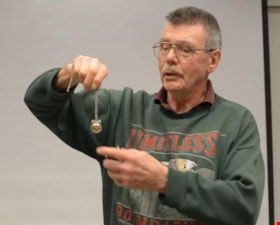Narrow Results By
Decade
- 2020s 25
- 2010s 25
- 2000s 29
- 1990s 32
- 1980s 39
- 1970s 28
- 1960s 30
- 1950s 43
- 1940s 42
- 1930s 78
- 1920s 36
- 1910s 29
- 1900s 24
- 1890s 12
- 1880s 6
- 1870s 2
- 1860s 3
- 1850s 1
- 1840s 3
- 1830s 1
- 1820s 1
- 1810s 1
- 1800s 1
- 1790s 1
- 1780s 1
- 1770s 1
- 1760s 1
- 1750s 1
- 1740s 1
- 1730s 1
- 1720s 1
- 1710s 1
- 1700s 1
- 1690s 1
- 1680s 1
- 1670s 1
- 1660s 1
- 1650s 1
- 1640s 1
- 1630s 1
- 1620s 1
- 1610s 1
- 1600s 1
Creator
- Adams, Edith 3
- Anderson, George M. (George McCullough), 1897- 1
- Atwood, Patricia 1
- Ballantyne, R. M. (Robert Michael), 1825-1894 1
- Ballentine, Teresa 5
- Belcastro, Arlene 1
- Binks, James 3
- Binning, Dr. Sadhu 1
- Braden, James A. (James Andrew), 1872-1955 1
- Brady, Mary J. 1
- British Columbia. Department of Education 1
- Browne, Gordon, 1858-1932 1
Person / Organization
- Alpha Secondary School 1
- Arora, Maninder 1
- Barnes, Hannah Victoria "Girlie" Love 1
- Barnet Lumber Company 56
- Barnet Mill 56
- Bateman, Caroline Mary Wettenhall 1
- Bateman, Mary Dale 1
- Bayntun, Charmaine "Sherrie" Yanko 2
- Beale, Mary 2
- Beamish, Agnes 1
- Beamish, William Randolph "Ran" 1
- Belcastro, Arlene 1
Interview with Prem Kaur Gill, Santokh Singh Gill and Mohinder Kaur Gill
https://search.heritageburnaby.ca/link/museumdescription19347
- Repository
- Burnaby Village Museum
- Date
- [1957-2022] (interview content), interviewed 11 Nov. 2022
- Collection/Fonds
- Burnaby Village Museum fonds
- Description Level
- Item
- Physical Description
- 1 sound recording (m4a) (118 min., 39 sec.) + 1 sound recording (mp3) (115 min., 20 sec.)
- Scope and Content
- Item consists of an oral history interview with Santokh "Gurmail" Singh Gill and Mohinder Kaur Gill and their daughter, Prem Kaur Gill conducted by interviewers, Anushay Malik and Rajdeep. The interview is conducted in English, Punjabi, Hindi and Urdu. The three members of the Gill family share the…
- Repository
- Burnaby Village Museum
- Collection/Fonds
- Burnaby Village Museum fonds
- Series
- Museum Oral Histories series
- Description Level
- Item
- Physical Description
- 1 sound recording (m4a) (118 min., 39 sec.) + 1 sound recording (mp3) (115 min., 20 sec.)
- Material Details
- Interviewers: Anushay Malik, Rajdeep Interviewees: Prem Kaur Gill, Santokh "Gurmail" Singh Gill and Mohinder Kaur Gill Location of Interview: Gill family residence on Warwick Avenue in Burnaby Interview Date: November 11, 2022 Total Number of tracks: 1 Total Length of all Tracks: (1:58:39) Digital master recording (m4a) was converted to mp3 for access on Heritage Burnaby
- Scope and Content
- Item consists of an oral history interview with Santokh "Gurmail" Singh Gill and Mohinder Kaur Gill and their daughter, Prem Kaur Gill conducted by interviewers, Anushay Malik and Rajdeep. The interview is conducted in English, Punjabi, Hindi and Urdu. The three members of the Gill family share their ancestral background, their personal experiences immigrating to Canada, living in Burnaby and working in British Columbia as South Asian immigrants. 00:00 – 27:34 Santokh “Gurmail” Singh Gill and Mohinder Kaur Gill share their migration stories and experiences living and working in British Columbia as South Asian immigrants and their eldest child, Prem Kaur Gill shares her own experiences as a child of South Asian immigrants and growing up in British Columbia as a South Asian Canadian. Gurmail Singh Gill was born in the District of Jalandhar and Mohinder Kaur Gill was born in Hoshiapur of the Indian state of Punjab. Gurmail describes how he moved from India to England with his family in 1957, immigrated to Canada from England in 1966, married his wife Mohinder in England in 1968 and brought his family (parents and two siblings) to Canada from England in 1970 and other relatives including his wife’s family in the 1970s and 1980s. Mohinder and Gurmail Gill recollect their arranged marriage in England in 1968, their immigration process and explain how they arrived in Burnaby residing with a cousin at 4649 Georgia Street until they were able to purchase their own home after a few years. Gurmail shares names and connections to the relatives that came to British Columbia before him. Gurmail and Mohinder tell how they lived in the basement of the house and rented out the upper floor to save money. The couple recall what they brought with them when they immigrated to Canada and Mohinder Kaur Gill tells of how before leaving India, she and her mother made a special rajai for her to take with her. Mohinder describes the process of making a rajai (a quilted blanket that was made by hand). Gurmail and Mohinder Gill talk about the challenges that they’ve experienced as new immigrants including not being fluent in English, the cold weather and not having very many family or friends nearby to provide support. They attended the Gurdwara on Ross Street or Akali Singh Sikh Society Gurdwara on Skeena in Vancouver. They explain how there was limited access to grocery stores that supplied Punjabi and Indian spices and other cooking supplies. They talk about how they used a food mill and mortar and pestle to grind their own spices and flour and how Mohinder often made traditional sweets like barfi and laddo and pakoras using pea flour when they couldn’t get Besan flour. 27:35 – 36:11 Gurmail provides more details on his family’s immigration story, including names of relatives, how his six siblings and parents all immigrated to British Columbia in 1970 and how in the early 1970s and mid 1980’s Gurmail and his family sponsored approximately 70 friends and relations from India (including Mohinder’s family) to immigrate to Canada. When Mohinder’s family arrived they lived with them in their house until they were able to purchase property next door and build their own home. Children in the families all attended elementary and high school in Burnaby which now amounts to three generations. 36:12 – 59:28 Gurmail and Mohinder Gill talk about their experiences of racial discrimination. Gurmail recalls members of the South Asian community, Dr. Hari Prakash Sharma, Harinder Mahil and Charan Gill starting the British Columbia Organization to Fight Racism. Gurmail tells of how he got involved contributing some of his union dues as a member of CAIMAW (Canadian Association of Industrial Mechanical and Allied Workers Union- Local 15) and as a friend of Charan Gill and Raj Chouhan of the Canadian Farm Workers Union. Gurmail Gill explains how he was a founding member of CAIMAW and treasurer until the union merged with the Canadian Auto Workers Union (in 1991). Mohinder and Gurmail tell of how people from the South Asian community were discouraged from wearing Punjabi dresses or head coverings for fear of being yelled at with racial slurs and how it was often scary to go outside. Many from their community often avoided attending the Akali Singh Gurdwara since a head covering was required and people were afraid of being a target. Gurmail provides details about his work with A1 Steel, how different unions were formed pertaining to various skillsets and jobs per company and how he became a member of CAIMAW Local 15 (foundry workers). Mohinder recollects her experiences as a mother, the daily tasks involved and friends that she made who’d also emigrated from Punjab. Mohinder describes how she designed and sewed many Punjabi dresses using her electric sewing machine and how she learned English by attending adult classes at a church on Commercial Drive. Mohinder and her mother attended the classes for two hours per day for six years at a cost of twelve dollars for ten weeks. Once Mohinder could speak a little English, she started working and was able to practice more. 59:29 – 1:06:08 Mohinder, Gurmail and Prem talk about some of their favourite traditional foods including corn roti and spinach curry and how they grow many of their own vegetables including peppers, eggplant, saag (spinach), onions, garlic, cilantro, zucchini, squash and fenugreek. Mohinder reflects on how access to Punjabi clothing and fabric stores in Vancouver has changed and that ready made food is now more available. Traditional foods were previously made from scratch with women gathering together and cooking for hours and now it’s gotten easier but more expensive and less of a community feel. 1:06:09- 1:55:20 Mohinder and Gurmail Gill discuss and share their perspectives and experiences on raising a family in the past versus today. Gurmail imparts that all of his siblings became educated and secured professional careers while he continued to work in the trades. Prem Kaur Gill shares her own experiences growing up and attending school in Burnaby. Gurmail and Mohinder Gill recall the type of suitcase that they brought with them when they immigrated and how they recently they got rid of it. Gurmail and the group reflect and discuss the confusion with racial identity terms that have been used in this country. They comment that South Asians were referred to as “Hindu” and “East Indian” and Indigenous peoples were referred to as “Indian” and the controversy and racism behind some of these terms. The group discusses the impact of the caste system and other discriminatory experiences and compare their experiences of living in England to living in Canada. Prem comments on how it’s just recently that South Asian customs, celebrations and practices have been recognized and celebrated here in Canada, like Diwali and yoga. They comment on how much of the language, culture and customs have been retained in Surrey where many can still communicate in Punjabi and don’t need to be fluent in English. The group discusses how many South Asians immigrants first lived and worked in Vancouver but with rising property prices many moved to Surrey expanding and establishing a much larger South Asian community with resources. The group discusses and compares the differing travel routes that many of them and their relatives took when immigrating and travelling between India and Canada. The group talks about Rajdeep’s ancestral village in India which is near the Gill village of Firozpur. Gurmail explains the origins and details behind his family name that was changed from “Shergill” to “Gill” and the name “Santokh” from his maternal side.
- History
- Interviewees' biographies: Santokh "Gurmail" Singh Gill was born in the District of Jalandhar in Punjab, India. Gurmail moved to England with his family in 1957 and immigrated to British Columbia in 1966. Gurmail married his wife, Mohinder Kaur Gill in England in 1968 and she immigrated to British Columbia from England soon after. Gurmail first lived with a cousin in Burnaby before purchasing a home of his own in Burnaby where he raised his family. Gurmail worked in the steel industry and was a member and treasurer of the CAIMAW before the union merged with the Canadian Auto Workers Union. Mohinder Kaur Gill was born in the Hoshiapur in Punjab, India. She married her husband Santokh "Gurmail" Singh Gill in England in 1968 and immigrated to Burnaby, British Columbia to join her husband. Mohinder and Gurmail Gill have four children, all born in Burnaby. Prem Kaur Gill was born in Burnaby in 1969 and is the eldest child of Santokh "Gurmail" Singh Gill and Mohinder Kaur Gill. Prem grew up and attended school in Burnaby. Interviewers' biographies: Anushay Malik is labor historian with a geographical focus on South Asia. Anushay studied at the University of London and was a research fellow at the International Institute of Social History in Amsterdam, Netherlands. In 2014, Anushay moved back to her native Pakistan and joined Lahore University of Management Services as an Assistant Professor. In 2023, Anushay is a visiting scholar at Simon Fraser University and lives in Burnaby with her family. Anushay was a co-curator of the Burnaby Village Museum exhibit “Truths Not Often Told: Being South Asian in Burnaby”. Rajdeep was born and raised in the Lower Mainland and is of Punjabi (South Asian) descent. She has an Associate of Arts degree in Asian Studies from Kwantlen Polytechnic University, a Bachelor of Arts (Hons.) in Anthropology from the University of British Columbia. She is a student in the Restoration of Natural Systems program at the University of Victoria. Rajdeep works at Simon Fraser University as a Program Assistant and as a researcher with the City of Burnaby. At Burnaby Village Museum, Rajdeep contributed to the exhibit “Truths Not Often Told: Being South Asian in Burnaby”.
- Creator
- Burnaby Village Museum
- Subjects
- Clothing
- Foods
- Indigenous peoples
- Buildings - Religious - Temples
- Food Processing Tools and Equipment
- Persons - South Asian Canadians
- Social Issues
- Social Issues - Racism
- Migration
- Occupations
- Organizations - Unions
- Responsibility
- Rajdeep
- Malik, Anushay
- Accession Code
- BV022.29.2
- Access Restriction
- No restrictions
- Reproduction Restriction
- No known restrictions
- Date
- [1957-2022] (interview content), interviewed 11 Nov. 2022
- Media Type
- Sound Recording
- Notes
- Title based on contents of item
- Transcript available upon request - contact Burnaby Village Museum
- Indian Family System Reference notes: Baba = informal way to say grandfather; old man Bibi = informal way to say grandmother; old woman Dada= paternal grandfather Dadi= paternal grandmother Dadke= paternal family members; paternal side (Various spellings might exist for the following terms) Thaiyya= father’s elder brother (uncle) Thaiyyi= father’s elder brother’s wife (aunt) Chacha= father’s younger brother (uncle) Chachi= father’s younger brother’s wife (aunt) Bua= father’s sister (older or younger) (aunt) Phuphar= father’s sister’s husband (uncle) Nana= maternal grandfather Nani= maternal grandmother Nanke/nanka= maternal family members; maternal side Mama= mom’s brother (older or younger) (uncle) Mami= mom’s brother’s wife (aunt) Maasi= mom’s sister (older or younger) (aunt) Maasard= mom’s sister’s husband (uncle)
Audio Tracks
Interview with Prem Kaur Gill, Santokh Singh Gill and Mohinder Kaur Gill, [1957-2022] (interview content), interviewed 11 Nov. 2022
Interview with Prem Kaur Gill, Santokh Singh Gill and Mohinder Kaur Gill, [1957-2022] (interview content), interviewed 11 Nov. 2022
https://search.heritageburnaby.ca/media/hpo/_Data/_BVM_Sound_Recordings/Oral_Histories/2022_0029_0002_002.mp3postcard; envelope; card
https://search.heritageburnaby.ca/link/museumartifact10424
- Repository
- Burnaby Village Museum
- Accession Code
- BV985.2551.4
- Description
- To My Dear Mother - Postcard. Small postcard with embroidered fabric centre. The British Union Jack and the French Flag are embroidered on the fabric along with small red flowers and green leafs. At the bottom of the fabric is "TO MY DEAR MOTHER". The fabric in the centre of the card is split into two pieces and unfolds to reveal a small card with a blue stamp on it with "To my dear Mother" written again. On the back of the postcard is room for a written message. The card was made in France. The postcard is 8.5cm x 13.5cm.
- Classification
- Written Communication T&E - - Writing Media
- Object Term
- Postcard
Images
42nd Burnaby Brownies 6th annual Canadian temple cathedral
https://search.heritageburnaby.ca/link/museumdescription5223
- Repository
- Burnaby Village Museum
- Date
- May 10, 1965
- Collection/Fonds
- Burnaby Girl Guides fonds
- Description Level
- Item
- Physical Description
- 1 photograph : col. ; 9.5 x 9 cm
- Scope and Content
- Photograph from the 6th Annual Mother & Daughter Banquet for the 42nd Burnaby Group, May 10, 1965. A group of four people are seated at a white clothed table and are identified from left to right as: District Guide member Mrs. Spriggs, Brown Owl and chairman-Mrs. T. Pearson, Anglican Bishop Rev. Dr…
- Repository
- Burnaby Village Museum
- Collection/Fonds
- Burnaby Girl Guides fonds
- Description Level
- Item
- Physical Description
- 1 photograph : col. ; 9.5 x 9 cm
- Scope and Content
- Photograph from the 6th Annual Mother & Daughter Banquet for the 42nd Burnaby Group, May 10, 1965. A group of four people are seated at a white clothed table and are identified from left to right as: District Guide member Mrs. Spriggs, Brown Owl and chairman-Mrs. T. Pearson, Anglican Bishop Rev. Dr. Voice (Pastor, Canadian Temple Cathedral & sponsor of the 42nd Burnaby Guides) and District Commissioner, Mrs. Isabelle Roper. Mrs. Helen Taylor is serving and is behind Mrs. Roper. There is a raised stage behind them along with a union jack flag and Girl Guide flag hanging from the ceiling. A photograph of Lady Baden Powell adorns the front of the table cloth along with a Canadian Flag, a graphic illustration of a Girl Guide in uniform and the number "6".
- Accession Code
- BV016.49.116
- Access Restriction
- No restrictions
- Reproduction Restriction
- May be restricted by third party rights
- Date
- May 10, 1965
- Media Type
- Photograph
- Notes
- Title based on content of photograph
- Note in black ink on verso of photograph reads: "6th Annual Mother & / Daughter Banquet_42nd Burnaby / Group. _ May 10th 1965 / D.G. Member Mrs. Spriggs / M___Pearson - Brown Owl / Chairman . Bishop / Rev. Dr. Voice - Pastor Canadian / Temple Cathedral & sponsor of / our group / Com. Mrs. Roper / Mrs. Helen Taylor serving / Thought you would like / this one. F.P."
Images
All round cord ceremony
https://search.heritageburnaby.ca/link/museumdescription5241
- Repository
- Burnaby Village Museum
- Date
- [ca. 1965]
- Collection/Fonds
- Burnaby Girl Guides fonds
- Description Level
- Item
- Physical Description
- 1 photograph : b&w ; 13 x 7.5 cm
- Scope and Content
- Photograph of Girl Guide, Sandy Hyslop and mother Pauline Hyslop. Sandy is being awarded her "All Round Cord" award in a ceremony. Sandy is dressed in uniform and holding her three right fingers up in a Girl Guide salute while shaking hands with her mother, Pauline Hyslop. The "All Round Cord" awar…
- Repository
- Burnaby Village Museum
- Collection/Fonds
- Burnaby Girl Guides fonds
- Description Level
- Item
- Physical Description
- 1 photograph : b&w ; 13 x 7.5 cm
- Scope and Content
- Photograph of Girl Guide, Sandy Hyslop and mother Pauline Hyslop. Sandy is being awarded her "All Round Cord" award in a ceremony. Sandy is dressed in uniform and holding her three right fingers up in a Girl Guide salute while shaking hands with her mother, Pauline Hyslop. The "All Round Cord" award also known as the "All Around Cord" award was in place between 1910 and 1993.
- Accession Code
- BV015.35.312
- Access Restriction
- No restrictions
- Reproduction Restriction
- May be restricted by third party rights
- Date
- [ca. 1965]
- Media Type
- Photograph
- Notes
- Title based on content of photograph
- Photograph was found loose in scrapbook BV015.35.159
- See also photographs BV016.49.122 and BV016.49.123
Images
autograph book
https://search.heritageburnaby.ca/link/museumartifact7129
- Repository
- Burnaby Village Museum
- Accession Code
- BV985.407.6
- Description
- Autograph Book - Booklet -- [1915]. Autograph book produced by Rose & Co at 44 Above Bar, Southhampton. The book was a gift to Mrs. Orman from the Teachers and Children of All Saints Sunday School, Eastleigh, Southhampton, upon her departure to Canada. The first four pages lists all the teachers and children's names. The front cover of the book is green with two painted purple flowers and "Autographs" embossed in white on the bottom right.
- Object History
- This accession appears to be connected to the Orman family. Ada Leila Orman was born June 2, 1901 in Eastleigh, Hampshire, England. According to the 1915 Census, the Orman family came to Canada in 1911 and settled in Calgary. Father Willoughby Henry Orman is listed there as working as a C.P.R. foreman, while mother Daisy Marie (Harklett) Orman worked at home. Older sister Daisy Hilda (Targett) Orman, worked as a stenographer. At five years old Leila began a long fight with a crippling type of rheumatoid arthritis. By the time she was thirteen, she experienced completely ankylosed joints. Her family travelled all over hoping to find a cure, but to no avail. While living in Calgary, Leila developed an interest in painting, knitting, and composing her own poems. She began writing news articles for the Calgary Daily Herald in the 1930s, and her first sonnet published was in that paper on August 28, 1934. She had a strong interest in the arts, often writing about music and the visual arts. While living in Calgary, she became a member of the Business and Professional Women’s Club as well as a member of the Canadian Author’s Association. Three members of the family moved to B.C. when Willoughby retired, ca. 1938. In the 1940 BC Directory, the family are listed as living at 407 Campbell Street, Burnaby. Willoughby died in Burnaby in 1945. Daisy Marie died in 1955 after living 15 years in Burnaby. Her address at the time of her death is listed as 407 Rosewood Avenue, Burnaby. Leila was living with her at that time. Older sister Daisy Hilda married Edgar Harold Targett in 1922. They moved to B.C. from Alberta some years after the other three members of the family (ca. 1962). Daisy Hilda died in 1972. Her address at the time of her death was 7969 Rosewood Avenue, Burnaby. Leila wrote on a typewriter with two sticks to type out the letters. She was an avid reader and was able to turn the pages with a special stick with elastic bands wound around the ends. Canadian novelist Maida Parlow French became her lifelong friend and encouraged her to write her own autobiography - unfortunately it was never finished. Leila wrote “The Giving Heart” in October of 1948. By 1952, she was writing a column for the British Columbia Saturday Magazine entitled “Across the Board” with the intention of inspiring other “incapacitated folk” to live up to their full potential, “If [she] could reach a few people, and encourage them to reach up and out, [she] should feel the effort well worthwhile.” A member of the St. Alban’s Prayer Healing Fellowship group, Leila wrote the “Christian Manifesto for World Peace” in 1963. The Prayer Group met twice monthly at one of the members’ homes and undertook to pray daily for the sick and for world peace. After Leila’s mother died in 1955, Leila’s friend Jeanie Brown kept house for her and was her constant companion. Jeanie Brown and Leila lived together for over thirteen years until an accident sent Leila to hospital and later to nursing home where she died on February 16, 1976.
Images
basket
https://search.heritageburnaby.ca/link/museumartifact27529
- Repository
- Burnaby Village Museum
- Accession Code
- HV974.119.3
- Description
- Rectangular coiled cedar root basket with cedar slat foundation, lid has parallel slat construction and is covered with beaded designs edged by imbrication in canary grass. Basket has a flat lid that is hinged to body with leather ties. A mistake was made in how the design was applied to one end of this basket. This is not common as many weavers would correct this mistake. Completely imbricated walls, beaded design on lid. Coast Salish: Sḵwx̱wú7mesh?
- Object History
- The donor reported that the baskets were traded in the early 1920s for clothes by the donor's mother, who lived in North Vancouver. Her mother told her the "Capilano Indians" used to go door to door with their baskets in North Vancouver.
- Diamonds are considered a star pattern and are common to Sḵwx̱wú7mesh and Nlaka’pamux basketry. The main design resembles a ladder or fence and is uncommon.
- Country Made
- Canada
- Province Made
- British Columbia
- Culture
- Sḵwx̱wú7mesh
Images
Documents
berry basket
https://search.heritageburnaby.ca/link/museumartifact27527
- Repository
- Burnaby Village Museum
- Accession Code
- HV974.119.1
- Description
- Trapezoidal shaped, coiled cedar root basket with cedar slat foundation. Finished with an overcast rim with root foundation. Design elements missing from one side of the basket, which is uncommon but has been seen on cradles from the Mount Currie area (Interior Salish: Lil'wat). It was perhaps the side that rests on the wearer's back. Steeply angled sides.
- Coast Salish: Sḵwx̱wú7mesh? Interior Salish: Stl’atl’imx: Lil’wat?
- Object History
- The donor reported that the baskets were traded in the early 1920s for clothes by the donor's mother, who lived in North Vancouver. Her mother told her the "Capilano Indians" used to go door to door with their baskets in North Vancouver.
- Design elements missing from one side of the basket – possibly the side that would have rested against the owner’s back.
- Steeply angled sides keep berries from crushing those at bottom of basket. Work baskets have sides that are more rounded.
- Baskets like these were used with a woven tumpline (wool strap) that was worn against the forehead, while basket was carried on back.
- Country Made
- Canada
- Province Made
- British Columbia
- Culture
- Stl’atl’imx
Images
Documents
button
https://search.heritageburnaby.ca/link/museumartifact4380
- Repository
- Burnaby Village Museum
- Accession Code
- BV988.48.55
- Description
- Card of buttons "Up-To-Date Fancy Glass Buttons", 12, purple and gold. [Ex-loan HV975.53.6]
- Object History
- Donor acquired object in 1951 from the estates of her mother, Margaret Isabel (Cinnamon) Wray, and her mother-in-law, Flora Isabell (McArthur) McOuat.
Images
button
https://search.heritageburnaby.ca/link/museumartifact4383
- Repository
- Burnaby Village Museum
- Accession Code
- BV988.48.58
- Description
- Card of buttons "Mode of Paris", 12 small pearl buttons [Ex-loan HV975.53.9]
- Object History
- Donor acquired object in 1951 from the estates of her mother, Margaret Isabel (Cinnamon) Wray, and her mother-in-law, Flora Isabell (McArthur) McOuat.
Images
Caroline Mary Bateman
https://search.heritageburnaby.ca/link/museumdescription905
- Repository
- Burnaby Village Museum
- Date
- [1881]
- Collection/Fonds
- E.W. Bateman family fonds
- Description Level
- Item
- Physical Description
- 1 photograph : sepia ; 9.2 x 5.8 cm mounted on card 10.2 x 6.2 cm
- Scope and Content
- Photograph of Caroline Mary Bateman at age fourty-two. Caroline Bateman has her hair parted in the middle with ringlets hanging over her shoulder. She is wearing earrings and dark coloured dress with a light ruffled piece at her throat. . Caroline Mary Bateman (the mother of E.W. Bateman) was the d…
- Repository
- Burnaby Village Museum
- Collection/Fonds
- E.W. Bateman family fonds
- Description Level
- Item
- Physical Description
- 1 photograph : sepia ; 9.2 x 5.8 cm mounted on card 10.2 x 6.2 cm
- Material Details
- printed on the card, recto, l.l., "MOON & SON.", l.r. "CREWE.", verso, t. "PORTRAIT AND/ LANDSCAPE/ PHOTOGRAPHERS", c. "W Moon + Son/ HIGH STREET/ CREWE.", b. "ADDITIONAL COPIES MAY BE HAD/ OLD PHOTOGRAPHS COPIED FOR CARTE DE VISITE/ AND ENLARGEMENTS / Marion, Imp. Paris"
- Scope and Content
- Photograph of Caroline Mary Bateman at age fourty-two. Caroline Bateman has her hair parted in the middle with ringlets hanging over her shoulder. She is wearing earrings and dark coloured dress with a light ruffled piece at her throat. . Caroline Mary Bateman (the mother of E.W. Bateman) was the daughter of Edwin Wettenhall, son of Lancaster Wettenhall, Rector of Lawton Church, Cheshire from 1782-1824. Caroline Mary Wettenhall married James Bateman.
- Accession Code
- HV975.120.7
- Access Restriction
- No restrictions
- Reproduction Restriction
- No known restrictions
- Date
- [1881]
- Media Type
- Photograph
- Scan Resolution
- 600
- Scan Date
- 2023-06-13
- Photographer
- W. Moon & Son
- Notes
- Title based on contents of photograph
- An annotation on the back of the card reads: "Mother / About 1881 / Edwin," and was likely written by Edwin Wettenhall Bateman. Edwin Bateman built the house "Elworth" located at the Burnaby Village Museum
- An annotation on the bottom recto of card reads: "Died 2 June 1891 / Age 52."
Images
Chinese Herbalist Shops and TCM
https://search.heritageburnaby.ca/link/museumdescription14274
- Repository
- Burnaby Village Museum
- Date
- 2020
- Collection/Fonds
- Burnaby Village Museum fonds
- Description Level
- Item
- Physical Description
- 1 sound recording (mp3) (00:16:19 min)
- Scope and Content
- Item consists of a recording of part three in a series of three “Back to the Roots” podcasts where the hosts Rose Wu and Wei Yan Yeong, "Dig up the roots of the past to unearth the foundations of the Chinese Canadian experience in Burnaby." This episode three is titled "Chinese Herbalist Shops and …
- Repository
- Burnaby Village Museum
- Collection/Fonds
- Burnaby Village Museum fonds
- Series
- UBC Partnership series
- Description Level
- Item
- Physical Description
- 1 sound recording (mp3) (00:16:19 min)
- Material Details
- Podcasts hosts: Rose Wu; Wei Yan Yeong Persons from recorded extracts: Denise Fong; Josephine Chow; Julie Lee Guest: Dr. John Yang Podcast Date: October 2020 Total Number of tracks: 1 Total Length of all tracks: 00:16:19 min Photograph info: Store front of Way Sang Yuen Wat Kee & Co in Victoria, B.C., 1975. BV017.7.191
- Scope and Content
- Item consists of a recording of part three in a series of three “Back to the Roots” podcasts where the hosts Rose Wu and Wei Yan Yeong, "Dig up the roots of the past to unearth the foundations of the Chinese Canadian experience in Burnaby." This episode three is titled "Chinese Herbalist Shops and TCM". The podcasts were created by students Rose Wu and Wei Yan Yeong from the Faculty of Land and Food Systems at the University of British Columbia Faculty and while student interns at Burnaby Village Museum. In this series the students connect their knowledge of food systems to their shared Chinese heritage in order to discover how Chinese Canadian history is rooted in their local food systems. 00:00 - 01:34 Podcast opens with an introduction to this episode in the podcast series. 01:35 - 03:43 This portion of the podcast consists of segments of pre-recorded interviews between Denise Fong and Chinese-Canadians Julie Lee and Josephine Chow who grew up in Burnaby. Josephine and Jule recall visiting herbalist shops in Vancouver's Chinatown during the nineteen fifties and sixties. Due to the lack of herbalist shops in the Burnaby community during that time, it was common for a Chinese farming family to travel to Vancouver’s Chinatown in order to obtain herbal prescriptions or dried goods. Julie speaks briefly about what the type of Traditional Chinese medical care and advice her mother and family received. Josephine Chow tells of a female Chinese doctor from Vancouver, Madeline Chung who was responsible for delivering a lot of Chinese babies including Josephine and describes how her mother would take members of the family to the herbalist in Vancouver's Chinatown. 03:44 - 04:44 In this portion, the hosts tell of how aside from its medicinal purposes, herbalist shops also have a major socio-cultural significance to the Chinese community. The hosts describe the traditional layout of Chinese herblist shops, with a table set up for the game Ma Jong in the back and a seating area where customers could chat while waiting and be served tea. The hosts provide an example of the "Way Sang Yuen Wat Kee & Co." herbalist shop in Victoria that was open between 1905 and 1967 and of how the shop and contents are now part of a permanent exhibit at the Burnaby Village Museum. 04:45 - 09:21 In this portion, the hosts describe "Traditional Chinese Medicine" also known as "TCM". In order to better understand the importance of TCM in Chinese culture, and specifically to Chinese-Canadian immigrants, the hosts interview Dr John Yang, the chairperson and program director of Kwantlen Polytechnic University's TCM program. Holding a PHD in TCM before migrating with his family to Canada, Dr Yang came here 30 years ago and immediately started his journey as a TCM practitioner at his home basement in Burnaby. Dr. Yang tells of how he worked with the lobbying group, ATCMA (The British Columbia Association of Traditional Chinese Medicine and Acupuncture Practitioners) to help legitimize TCM as a recognized form of medical health care. In 1996, the Canadian government finally approved the legitimization of TCM in Canada, where one is required to take a licensing exam before they’re allowed to start their practices in Canada. 09:22 - 15:17 In this portion of the podcast, Dr. Yang and hosts describe how Traditional Chinese Medicine and treatments differ from Western medicine, how TCM is a way of life and regularly incorporated into recipes and diets, the lack of social acceptance and the import of Chinese medicinal herbs and misconceptions. 15:18 - 16:19 Conclusion, credits and acknowledgements.
- History
- Podcast hosts, Rose Wu and Wei Yan Yeong are University of British Columbia students in the Faculty of Land and Food Systems and student interns at Burnaby Village Museum.
- Creator
- Burnaby Village Museum
- Subjects
- Persons - Chinese Canadians
- Social Issues - Discrimination
- Social Issues - Racism
- Public Services - Health Services
- Names
- Lee, Julie Cho Chan
- Chow, Josephine
- Fong, Denise
- Yang, Dr. John
- Way Sang Yuen Wat Kee & Company
- Burnaby Village Museum
- Responsibility
- Wu, Rose
- Yeong, Wei Yan
- Accession Code
- BV020.28.5
- Access Restriction
- No restrictions
- Reproduction Restriction
- No known restrictions
- Date
- 2020
- Media Type
- Sound Recording
- Related Material
- BV020.28.3; BV020.28.4
- Notes
- Title based contents of sound recording
- See also Interview with Josephine Chow by Denise Fong February 7, 2020 - BV020.6.1; Interview with Julie Lee by Denise Fong February 6, 2020 - BV020.6.2
- For associated video recording of research interview with Dr. John Yang - see BV020.28.1
- Compilation of Research Resources used by authors Rose Wu and Wei Yan Yeong include:
- B.C. to recognize doctors of Chinese medicine: https://www.cbc.ca/news/canada/b-c-to-recognize-doctors-of-chinese-medicine-1.396806
- B.C. takes steps to legitimize traditional Chinese medicine: https://www.theglobeandmail.com/news/national/bc-takes-steps-to-legitimize-traditional-chinese-medicine/article18428851/
- Traditional Chinese medicine moves into the mainstream https://www.straight.com/life/415386/traditional-chinese-medicine-moves-mainstream
- Burnaby Village Museum - Interview with Josephine Chow by Denise Fong Feb. 7, 2020. BV020.6.1 https://search.heritageburnaby.ca/permalink/museumsoundrecording12337
- Burnaby Village Museum, Interview with Julie Lee by Denise Fong Feb. 6, 2020. BV020.6.2 https://search.heritageburnaby.ca/permalink/museumsoundrecording12338
Images
Audio Tracks
Chinese Herbalist Shops and TCM, 2020
Chinese Herbalist Shops and TCM, 2020
https://search.heritageburnaby.ca/media/hpo/_Data/_BVM_Sound_Recordings/Sound_Recordings/2020_0028_0005_001.mp3dress
https://search.heritageburnaby.ca/link/museumartifact46563
- Repository
- Burnaby Village Museum
- Accession Code
- BV004.21.6
- Description
- Dress, c.1920. Purple silk satin with lace applique on sleeves. High collar with bow, buttons centre front, slightly flared ankle length skirt. Bias side panels on skirt. This dress seems characteristic of an item that would appeal to its particular owner. Born in 1880, she is following 1920s trends somewhat with the straight cut and bias skirt inserts, but also staying true to the fashion of her youth that she is comfortable with: a high collar, longer skirt, scarf, and lace applique are all borrowed from her time in the belle epoque. Extending from the stand collar are two long ties that could be tied into a bow or square knot. Directly under this at centre front is the opening with thirteen self fabric covered buttons. There is a bust dart on each side front, and a welt pocket on each side front just above the hips. At a dropped waist, there is a somewhat flared gore on each side of the skirt that extends from side front to back. The skirt extends to just above the ankles, with a small double fold hem. Inside, the dress is unlined; its seams are finished with a whip stitch. The garment was likely made by its owner.
- Object History
- Object was inherited by the donor ca. 1974. She was given it by her mother, who had inherited it from her own mother, Elizabeth (Babb) Heaney.
- Colour
- Purple
- Subjects
- Clothing
- Clothing - Costumes
- Historic Neighbourhood
- Central Park (Historic Neighbourhood)
- Planning Study Area
- Maywood Area
Images
dress
https://search.heritageburnaby.ca/link/museumartifact46564
- Repository
- Burnaby Village Museum
- Accession Code
- BV004.21.7
- Description
- Dress, c.1914-1918. White cotton pique. Calf length, three quarter length sleeves, buttons down centre front and up to neckline, waistband and cuffs. The tight collar is edged with a scalloped trim; the right side of the collar extends diagonally to the right, making a slight V neck, and turns down the centre front. The trim follows the line to the waistband. At each shoulder just before the sleeve, there is a pleat that opens up. On the front at the waistband, there is some gathering in the waistband, and some small pleats at centre back. On the bodice front right, there is a small pocket that ends in a triangle shape and is topped with scalloped edging. The sleeves are plain set-in, with fairly wide cuffs that turn up and are left open at the side. Down the whole centre front there is an opening. Each side has holes, but no buttons remain: on the right, regular button holes and on the left, small bound holes. The waistband is a two inch strip. Attached is the skirt in six slightly flared gores.
- Object History
- Object was inherited by the donor ca. 1974. She was given it by her mother, who had inherited it from her own mother, Elizabeth (Babb) Heaney.
- Colour
- White
- Subjects
- Clothing
- Clothing - Costumes
- Historic Neighbourhood
- Central Park (Historic Neighbourhood)
- Planning Study Area
- Maywood Area
Images
dress
https://search.heritageburnaby.ca/link/museumartifact46565
- Repository
- Burnaby Village Museum
- Accession Code
- BV004.21.8
- Description
- Dress, c.1910-1913. Cotton lawn print in floral and checkered, with chiffon yoke, lace, and mauve satin silk waistband. Long tiered skirt, long sleeves, round neckline. The cotton lawn fabric has a white background with vertical stripes of black and white checkers; purple flowers with green stems intertwine around the vertical checkers. The neckline rounds into a slight V shape with a yoke of ivory chiffon on top of lace, which extends to the waistband. On the front and back right and left side of the bodice, there is a tab extending over the waistband from the bodice fabric, edged in lace. The bottom of the bodice is gathered to add some volume. The bodice is also open around the shoulders, edged with lace. There is a section of the main fabric underneath that connects to the lining. The sleeves are full length, with some volume. The cuff begins halfway down the forearm with a gathered lace ruffle. The cuff section is narrower, and ends with three snaps at the wrist and another lace ruffle. At the waist, there is a gathered mauve satin silk waistband, tacked on to the dress. The skirt is attached underneath in two tiers. The overskirt, attached to the bodice, has two somewhat flared gores and one godet on the right side seam from just above the knee to the calf. It also ends at the calf, and just above the hem there is a tiny band of drawn thread work embroidery. The bottom tier is attached to the skirt lining under the top hem; it is made up of four gores, all gathered. The lining to the dress is done in ivory china silk, and it extends into the sleeves. In the bodice lining, there are four bones to hold its shape: on in the centre front and back, and one on each side. There are six panels in the back and four in the front, all finished with flat felled seams. The centre front closes with hook and eyes, and the waistband is secured on top with snaps and a hook and eye; the left bodice tab is secured to the waistband with two snaps. The skirt lining is also china silk, closing down the left side front with snaps. The skirt also has a left side opening that closes with snaps. In each underarm there is a dress shield to protect the dress from perspiration. They each read: "Style 100 Trade Mark OMO. E. Y. 2. Odorless. No Rubber. Soak in cold soap suds, using good soap, scrub with a stiff brush, and rinse in clear cold water, shape carefully while wet, and dry thoroughly. Do not iron."
- Object History
- Object was inherited by the donor ca. 1974. She was given it by her mother, who had inherited it from her own mother, Elizabeth (Babb) Heaney.
- Subjects
- Clothing
- Clothing - Costumes
- Historic Neighbourhood
- Central Park (Historic Neighbourhood)
- Planning Study Area
- Maywood Area
Images
Dr. Sadhu Binning fonds
https://search.heritageburnaby.ca/link/museumdescription19279
- Repository
- Burnaby Village Museum
- Date
- [1984]
- Collection/Fonds
- Dr. Sadhu Binning fonds
- Description Level
- Fonds
- Physical Description
- 2 photographs : col.
- Scope and Content
- Fonds consists of two photographs of actors from Vancouver Sath performing in the play "Maluka" at Sexsmith Elementary School.
- Repository
- Burnaby Village Museum
- Collection/Fonds
- Dr. Sadhu Binning fonds
- Description Level
- Fonds
- Physical Description
- 2 photographs : col.
- Scope and Content
- Fonds consists of two photographs of actors from Vancouver Sath performing in the play "Maluka" at Sexsmith Elementary School.
- History
- Dr. Sadhu Binning was born on May 10, 1947 to mother Gurmej Kaur and father Jeet Singh Binning. Due to lack of proper records management in India at the time of his birth, it is believed that he was actually born sometime in December of 1947. He grew up alongside two brothers and one sister in a village located in Kapurthala, Punjab. Dr. Binning attended secondary school in the nearby city of Phagwara, Punjab although he did not complete his education here. Throughout his childhood, he enjoyed reading both Punjabi and Hindi novels and learned how to read Urdu as well. Dr. Binning’s uncle, Dhana Singh immigrated to Canada in 1933 and returned to India in 1953. When Dhana Singh returned to Canada in 1957, he sponsored Dr. Binning’s father, Jeet Singh Binning to immigrate. Dhana Singh co-owned a few saw mills in British Columbia and also worked in the truck driving industry. Dr. Binning remembers that some people who had lived in Canada would visit their village and that they appeared to be strong and healthy and looked happy. He also noticed that they would eat meat, so whenever they would visit there would be meat available. In 1967, when he was nineteen and a half years old, Dr. Binning immigrated Canada to join his father. He recalls his father and uncle and a friend arriving at the airport to pick him up. During his first few days, Dr. Binning made the decision to remove his turban and beard upon receiving advice from his uncle. Dr. Binning first obtained work on a farm in Abbotsford, working alongside his mother. While working, Dr. Binning also attended English classes in Vancouver. Dr. Binning’s Uncle Dhana Singh worked in a Vancouver saw mill and tried to help find work for his nephew but was unsuccessful. Dr. Binning soon found work at a saw mill in Avola and worked there until the end of the summer until a friend helped find him work in a saw mill in North Vancouver. During his free time, he enjoyed camping with friends. In 1970, Dr. Binning left the saw mill after obtaining a job at the post office. The post office offered lower wages than working at the mill but Dr. Binning believed that he would become more educated working here. While working as a postman, Dr. Binning recalls facing a lot of discrimination and racism and was often referred to as a ‘Paki’ multiple times a day. In 1973, Dr. Binning married Jagish Sihota. Sadhu and Jagdish originated from nearby villages in India and met each other in Canada. Dr. Binning’s wife, Jagdish worked at the Royal Bank of Canada for thirty years until her retirement. While working, she also looked after the household and their son and daughter. Jagdish also handwrote a magazine, “Watno Dur’ (English translation: ‘away from homeland’) which was distributed in the community. In 1976, Dr. Binning became the editor of the magazine and the name was later changed to “Watan’ as they had accepted their new homeland of Canada. While working at the post office, Dr. Binning also attended night school starting in eighth grade. After receiving his high school diploma, he was accepted to Simon Fraser University and earned a Bachelor of Arts degree with a double major in Anthropology and Sociology and in 1986 he obtained a Masters degree from Simon Fraser University. While attending university, Dr. Binning was very active within the community and wanted to work to improve society. He first thought that he would return to India to contribute and improve rights in his homeland but upon seeing the prevalence of the movements in Canada, he realized that work needed to be done here too. In 1983, Dr. Binning became a founding member and contributor to a theatrical collective known as “Vancouver Sath”. The theatrical group produced plays that represented societal issues and were invited to perform at multiple conferences throughout British Columbia and Canada. The group focused and acknowledged the many issues in Punjab and in Canada. One of the plays that the group produced focused on the exploitation of Punjabi women who worked on farms in Canada. Dr. Binning continued to be involved as an integral member of Vancouver Sath until 1995. Over the years, Dr. Binning has strongly lobbied for Punjabi language education and between 1988 and 2008 he worked as Punjabi instructor at the University of British Columbia. He first worked as a teaching assistant at UBC under Dr. Harjot Oberoi and due to low wages, he simultaneously worked at the Post Office. In 2019, Dr. Binning received an Honorary Doctor of Letters from UBC in recognition of his work. Since 1973, Dr. Binning has lived in Burnaby and has resided in the same home that he and his wife purchased in 1987. In his free time, he enjoys cycling, watercolour painting, travelling abroad and going on road trips.
- Creator
- Binning, Dr. Sadhu
- Accession Code
- BV023.7
- Date
- [1984]
- Media Type
- Photograph
- Related Material
- See also artifacts descriptions for related materials re: Vancouver Sath and Watan magazine: BV023.7.1 to BV023.7.16
- Notes
- Title based on contents of fonds
Edith Fleming
https://search.heritageburnaby.ca/link/museumdescription5130
- Repository
- Burnaby Village Museum
- Date
- [ca. 1900]
- Collection/Fonds
- Waplington family fonds
- Description Level
- Item
- Physical Description
- 1 photograph : col. print ; 12.5 x 9 cm
- Scope and Content
- Photograph of Edith Fleming (nee Barlow) (1877-1929) who married Reyland Corbett Fleming and is the mother of Ray and Eric Fleming.
- Repository
- Burnaby Village Museum
- Collection/Fonds
- Waplington family fonds
- Description Level
- Item
- Physical Description
- 1 photograph : col. print ; 12.5 x 9 cm
- Scope and Content
- Photograph of Edith Fleming (nee Barlow) (1877-1929) who married Reyland Corbett Fleming and is the mother of Ray and Eric Fleming.
- Names
- Fleming, Edith Barlow
- Accession Code
- BV016.46.85
- Access Restriction
- No restrictions
- Reproduction Restriction
- No known restrictions
- Date
- [ca. 1900]
- Media Type
- Photograph
- Scan Resolution
- 600
- Scan Date
- 13-Aug-2018
- Notes
- Title based on note on verso of photograph
- Note in blue ink on verso of photograph reads: "Ray Fleming's / mother / Edith Barlow"
- Photograph is part of Photograph album BV016.46.52
Images
Elderly woman and baby
https://search.heritageburnaby.ca/link/museumdescription1534
- Repository
- Burnaby Village Museum
- Date
- July 1936
- Collection/Fonds
- Burnaby Village Museum Photograph collection
- Description Level
- Item
- Physical Description
- 1 photograph : b&w ; 7 x 11 cm
- Scope and Content
- Photograph of an elderly woman seated on a chair on the lawn. She is holding a baby in her arms, and by her feet, there is a cat crouching down. According to the inscription on the photograph, it was taken on the occasion of the elderly woman's (referred to as Mother Laugley or Langley) 90th birthd…
- Repository
- Burnaby Village Museum
- Collection/Fonds
- Burnaby Village Museum Photograph collection
- Description Level
- Item
- Physical Description
- 1 photograph : b&w ; 7 x 11 cm
- Material Details
- inscribed in black ink, verso, t. "Mother Laugley [or Langley]/ taken on/ Mothers 90th/ birthday 1936/ + Eva's Babe", stamped, u.r. "B35"
- Scope and Content
- Photograph of an elderly woman seated on a chair on the lawn. She is holding a baby in her arms, and by her feet, there is a cat crouching down. According to the inscription on the photograph, it was taken on the occasion of the elderly woman's (referred to as Mother Laugley or Langley) 90th birthday in 1936, along with "Eva's babe".
- Subjects
- Animals - Cats
- Accession Code
- BV985.5901.5
- Access Restriction
- No restrictions
- Reproduction Restriction
- No known restrictions
- Date
- July 1936
- Media Type
- Photograph
- Related Material
- For other photographs of the elderly woman, see BV985.5901.2 and .4
- Scan Resolution
- 600
- Scan Date
- 2024-02-27
- Notes
- Title based on contents of photograph
Images
Eleanor, Louise, H.S. Irwin and grandmother Taylor at Barnet
https://search.heritageburnaby.ca/link/museumdescription15246
- Repository
- Burnaby Village Museum
- Date
- [1929] (date of original), copied 2004
- Collection/Fonds
- In the Shadow by the Sea collection
- Description Level
- Item
- Physical Description
- 1 photograph (tiff) : 300 dpi
- Scope and Content
- Photograph of Eleanor Irwin Nelson (left), Louise Irwin (in front), Harvey Stanley Irwin and his mother in law, Elizabeth (Shephard) Taylor in the garden of the manager's residence at the Barnet mill.
- Repository
- Burnaby Village Museum
- Collection/Fonds
- In the Shadow by the Sea collection
- Description Level
- Item
- Physical Description
- 1 photograph (tiff) : 300 dpi
- Scope and Content
- Photograph of Eleanor Irwin Nelson (left), Louise Irwin (in front), Harvey Stanley Irwin and his mother in law, Elizabeth (Shephard) Taylor in the garden of the manager's residence at the Barnet mill.
- History
- Henry Stanley Irwin (1890-1966) started work at Barnet mill in 1924. Henry and his wife Elsie May Irwin (Taylor) Irwin (1894-1985) first lived with thier two daughters, Eleanor (Nelson) (1924-2005) and Louise (1927-) in a worker's cabin before moving to the Barnet Mill's managers' residence. The household included Elsie's mother, Elizabeth (Shephard) Taylor (1868-1950). The family resided at Barnet until they moved to Vancouver in September 1939. Louise and her older sister Eleanor attended Barnet School like other children in the Barnet area. After the mill closed in 1931, Henry was unemployed for two years, during this time, he hired a horse and driver and cut logs from the slopes of Burnaby Mountain to support his family.
- Names
- Barnet Mill
- Barnet Lumber Company
- Nelson, Eleanor Irwin
- Irwin, Louise
- Irwin, Henry Stanley
- Taylor, Elizabeth Shephard
- Geographic Access
- Burrard Inlet
- Accession Code
- BV019.32.65
- Access Restriction
- No restrictions
- Reproduction Restriction
- No known restrictions
- Date
- [1929] (date of original), copied 2004
- Media Type
- Photograph
- Historic Neighbourhood
- Barnet (Historic Neighbourhood)
- Planning Study Area
- Burnaby Mountain Area
- Notes
- Title based on contents of photograph
- See page 47 of book "In the Shadow by the Sea: Recollections of Burnaby's Barnet Village" with caption "...Left to Right: Eleanor Irwin, Louise Irwin, Mr. Irwin and Grandmother Irwin, 1929"
Images
Film of Dave Linton discussing Gilmore Avenue School
https://search.heritageburnaby.ca/link/museumdescription5117
- Repository
- Burnaby Village Museum
- Date
- January 17, 2017
- Collection/Fonds
- 100 Years of Gilmore School video collection
- Description Level
- Item
- Physical Description
- 1 video recording (mp4) (51 sec.) : digital, 23 fps, col., sd., stereo
- Scope and Content
- Recording is an anecdote shared by Dave Linton pertaining to Gilmore Avenue School in Burnaby. Dave displays a medallion which was awarded to his mother by the Burnaby School Board for perfect attendance between the years 1921-1929. Dave attended Gilmore Avenue School, but it is unclear which schoo…
- Repository
- Burnaby Village Museum
- Collection/Fonds
- 100 Years of Gilmore School video collection
- Description Level
- Item
- Physical Description
- 1 video recording (mp4) (51 sec.) : digital, 23 fps, col., sd., stereo
- Material Details
- Film recorded at the McGill Library on January 17, 2017 as part of an event to screen "100 Years of Gilmore School" by filmmaker Yunuen Perez Vertti.
- Scope and Content
- Recording is an anecdote shared by Dave Linton pertaining to Gilmore Avenue School in Burnaby. Dave displays a medallion which was awarded to his mother by the Burnaby School Board for perfect attendance between the years 1921-1929. Dave attended Gilmore Avenue School, but it is unclear which school his mother attended. Asked her name, he replies “Stark”.
- Creator
- Perez Vertti, Yunuen
- Subjects
- Buildings - Schools
- Accession Code
- BV017.48.2
- Access Restriction
- No restrictions
- Reproduction Restriction
- No known restrictions
- Date
- January 17, 2017
- Media Type
- Moving Images
- Historic Neighbourhood
- Vancouver Heights (Historic Neighbourhood)
- Planning Study Area
- Burnaby Heights Area
- Notes
- Title based on contents of film
Images
Video
Film of Dave Linton discussing Gilmore Avenue School, January 17, 2017
Film of Dave Linton discussing Gilmore Avenue School, January 17, 2017
https://search.heritageburnaby.ca/media/hpo/_Data/_BVM_Moving_Images/2017_0048_0002_001.mp4Florence Hart Godwin fonds
https://search.heritageburnaby.ca/link/museumdescription14283
- Repository
- Burnaby Village Museum
- Date
- 1893-1923 (date of original), copied 1976
- Collection/Fonds
- Florence Hart Godwin fonds
- Description Level
- Fonds
- Physical Description
- 2 photograph albums (60 photographs)
- Scope and Content
- Fonds consists of photographic reproductions of two photograph albums. One album was owned and created by Florence Hart Godwin and the other by Florence Hart Godwin's mother, Alice Hart (nee Chapman). The albums consist of photographs of the Hart family and members of the Chapman family while they …
- Repository
- Burnaby Village Museum
- Collection/Fonds
- Florence Hart Godwin fonds
- Description Level
- Fonds
- Physical Description
- 2 photograph albums (60 photographs)
- Scope and Content
- Fonds consists of photographic reproductions of two photograph albums. One album was owned and created by Florence Hart Godwin and the other by Florence Hart Godwin's mother, Alice Hart (nee Chapman). The albums consist of photographs of the Hart family and members of the Chapman family while they had residences in New Westminster, Deer Lake and Kerrisdale along with time spent at Pitt Lake, Mayne Island, Stanley Park and Victoria. Albums are described at file level and album pages are described at item level.
- History
- Florence Elizabeth Hart Godwin was born in New Westminster in 1898 to parents, Frederick John Hart (1884- 1945) and Alice Hart (nee Chapman) (1885-1935). Alice and Frederick Hart were married in Yale in 1895 and had five children, Kingsley (1897-1916), Florence (1898-1999), Alice Fredricka “Freda” (1903-1905), Edwyna Jane (1907-1997) and Frederick John “Jack” (1908-2001). Alice Hart (nee Chapman) was the daughter of Edward Chapman and Jane Chapman (nee Isbell) born in Birmingham England and Frederick John Hart was born in Trinity, Newfoundland. Florence’s father Frederick J. Hart owned a successful real estate business in New Westminster from 1891. His real estate company managed many of the property sales in the lower mainland including Burnaby and he was involved with a number of economic development companies in the area. Frederick also served as alderman with the City of New Westminster. In June 1905, the family was heartbroken by the sudden death of Florence's younger sister Freda who died at age two of meningitis. In that same year, Frederick purchased 13 acres of land abutting the north east end of Deer Lake and built a small summer house "Avalon". Florence, her siblings and mother spent the summer months on the lake. Her father, Frederick worked in New Westminster during the week and joined them on the weekends. In 1910, Florence’s father built a larger permanent family residence at this location also named "Avalon". Mr. Frank W. Macey designed the house which is now the home of “Hart House” restaurant. While living in Burnaby, the family attended St. Alban’s Church and Florence was taught by Miss Harriet Woodward who had a small private school inside her home. Florence later attended Douglas Road school before being placed in Crofton House School in Vancouver. The Hart children found many playmates on the lake, including members of the Hill and Peers families. During World War One, in December of 1916, Florence's brother, Kingsley Hart was killed while serving overseas. This tragedy devastated Florence's parents and prompted them to sell "Avalon" in 1917 and move to Kerrisdale in Vancouver. In August 1922, Florence married Harold Ward Godwin at St. Mary's Church in Kerrisdale and they moved into their own home in Burnaby. That same year, Florence joined the auxiliary to the Victorian Order of Nurses. Florence made rounds as a nurse travelling from home to home on a bicycle. Florence and Harold had one child, Elizabeth Joy Hart (1929-1978) who later married Robert Carl Freyman (1925-2011) and worked as a nurse. In 1950, Florence was awarded a life membership to the V.O.N. along with her husband, making them the only husband and wife in Canada to be accorded this honour. By 1973, Florence had served more than 50 years as a member of the Board of the V.O.N. in Burnaby. In that same year, Florence was presented a life membership by the I.O.D.E. for her many contributions to the work of the organization.
- Creator
- Godwin, Florence Hart
- Accession Code
- HV976.168
- HV976.169
- Date
- 1893-1923 (date of original), copied 1976
- Media Type
- Photograph
- Notes
- Title based on contents of fonds
- 60 b&w copy prints + negatives accompanying
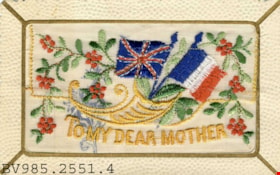
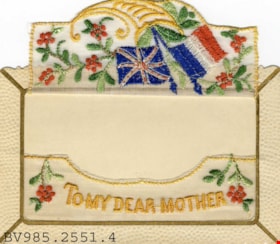
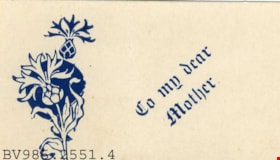
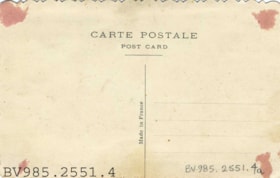
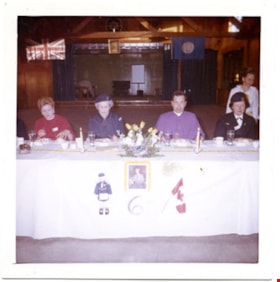
![All round cord ceremony, [ca. 1965] thumbnail](/media/hpo/_Data/_BVM_Images/2015/2015_0035_0312_001.jpg?width=280)
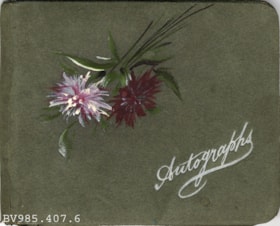
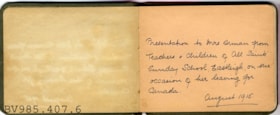



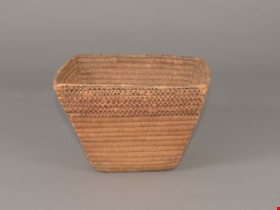
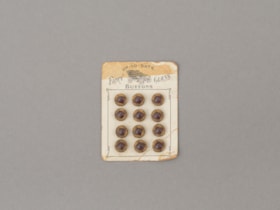
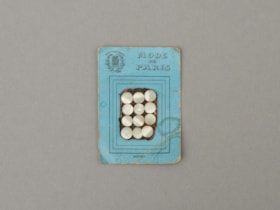
![Caroline Mary Bateman, [1881] thumbnail](/media/hpo/_Data/_BVM_Images/1975/1975_0120_0007_001.jpg?width=280)
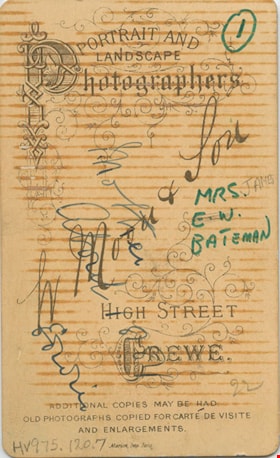

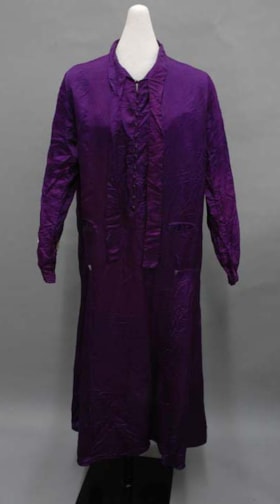
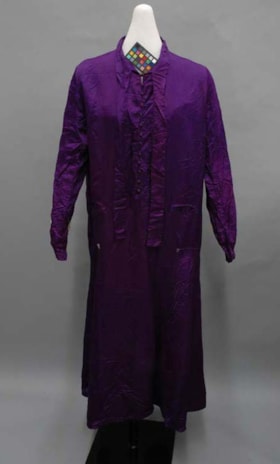
.jpg?width=280)
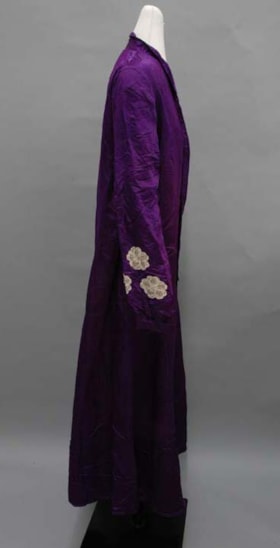
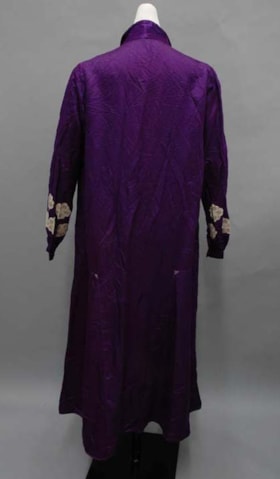
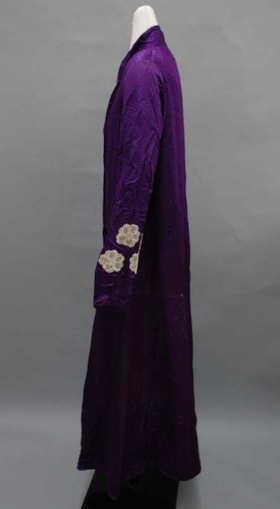
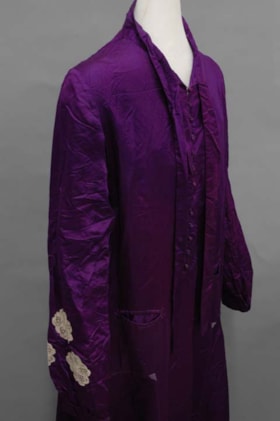
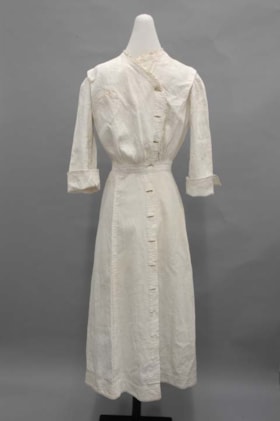
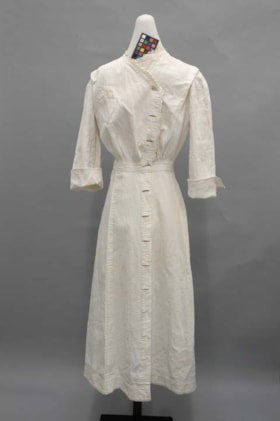
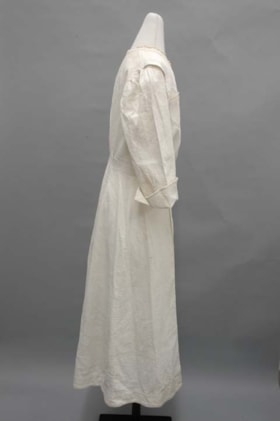
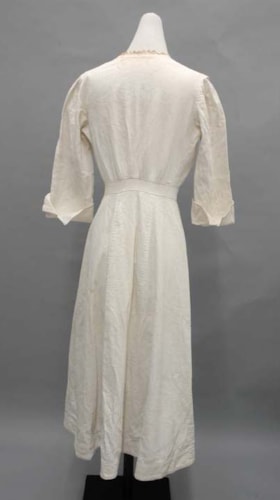
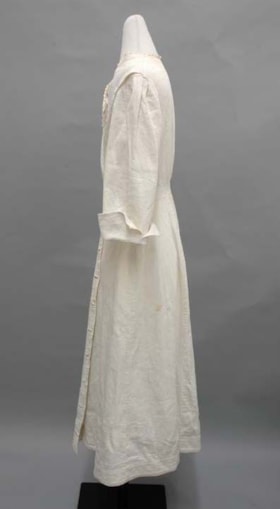
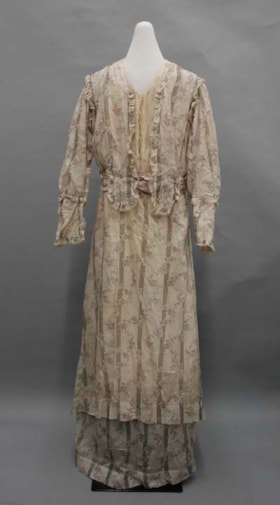
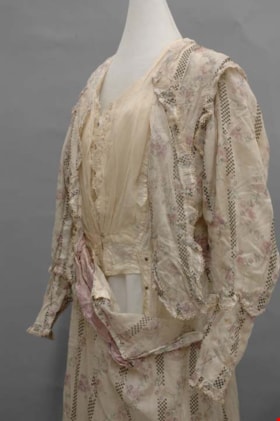
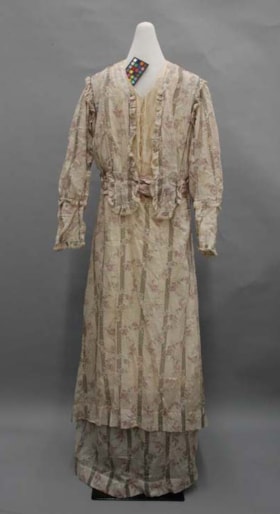
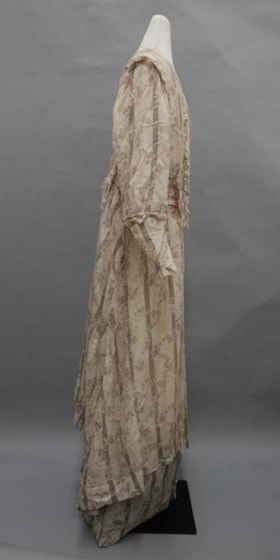
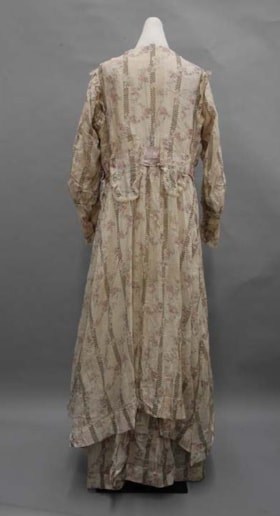
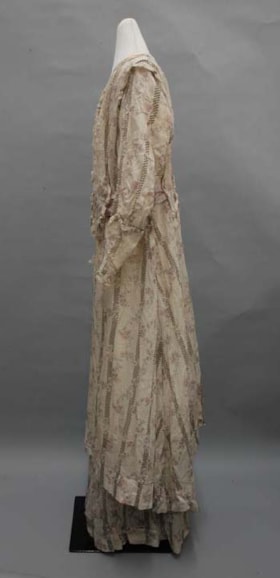
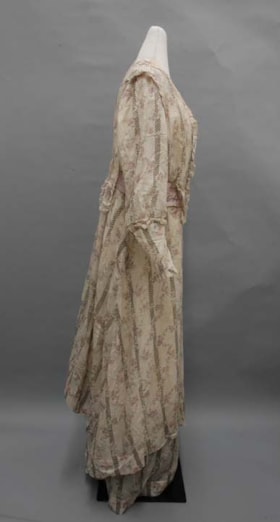
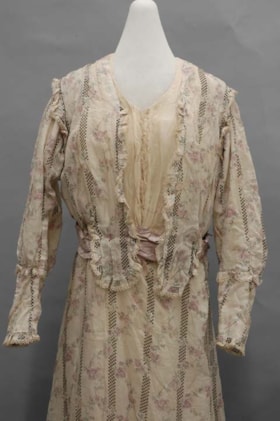
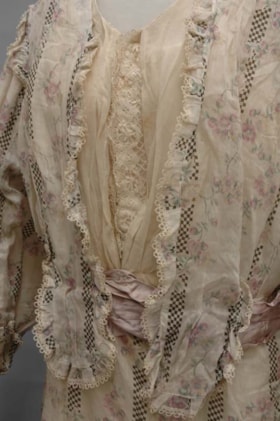
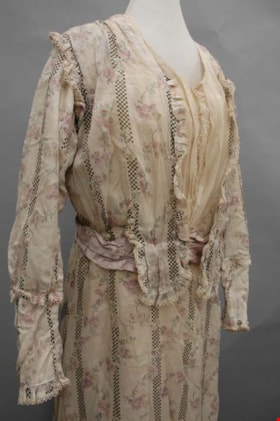
![Edith Fleming, [ca. 1900] thumbnail](/media/Hpo/_Data/_BVM_Images/2016/2016_0046_0085_001.jpg?width=280)
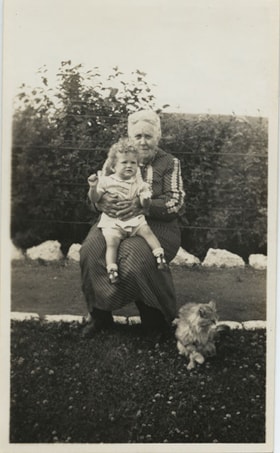
![Eleanor, Louise, H.S. Irwin and grandmother Taylor at Barnet, [1929] (date of original), copied 2004 thumbnail](/media/hpo/_Data/_BVM_Images/2019/2019_0032_0065_001.jpg?width=280)
